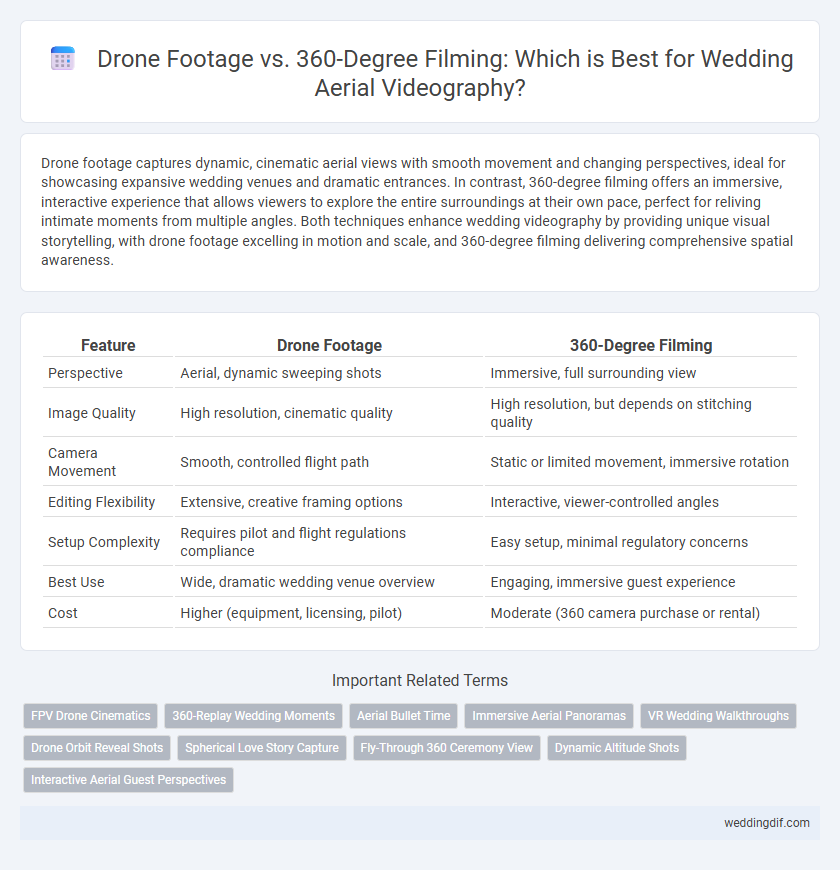Drone footage captures dynamic, cinematic aerial views with smooth movement and changing perspectives, ideal for showcasing expansive wedding venues and dramatic entrances. In contrast, 360-degree filming offers an immersive, interactive experience that allows viewers to explore the entire surroundings at their own pace, perfect for reliving intimate moments from multiple angles. Both techniques enhance wedding videography by providing unique visual storytelling, with drone footage excelling in motion and scale, and 360-degree filming delivering comprehensive spatial awareness.
Table of Comparison
| Feature | Drone Footage | 360-Degree Filming |
|---|---|---|
| Perspective | Aerial, dynamic sweeping shots | Immersive, full surrounding view |
| Image Quality | High resolution, cinematic quality | High resolution, but depends on stitching quality |
| Camera Movement | Smooth, controlled flight path | Static or limited movement, immersive rotation |
| Editing Flexibility | Extensive, creative framing options | Interactive, viewer-controlled angles |
| Setup Complexity | Requires pilot and flight regulations compliance | Easy setup, minimal regulatory concerns |
| Best Use | Wide, dramatic wedding venue overview | Engaging, immersive guest experience |
| Cost | Higher (equipment, licensing, pilot) | Moderate (360 camera purchase or rental) |
Introduction: The Evolution of Wedding Aerial Videography
Wedding aerial videography has evolved significantly with the advent of drone footage and 360-degree filming, transforming how couples capture their special day from above. Drone footage offers dynamic, cinematic visuals with sweeping panoramic shots that highlight venue scale and scenery, while 360-degree filming immerses viewers in a fully interactive environment, allowing them to explore every angle of the ceremony and reception. These technologies provide distinct storytelling methods, enhancing the emotional and visual impact of wedding videos through innovative aerial perspectives.
What is Drone Footage in Wedding Videos?
Drone footage in wedding videos captures stunning aerial perspectives using remotely piloted cameras, offering dynamic and cinematic views of the venue and ceremony. This method provides high-resolution, smooth tracking shots that highlight expansive landscapes and crowd interactions from above. Compared to 360-degree filming, drone footage emphasizes directional storytelling and visual depth, enhancing the emotional impact of wedding cinematography.
Understanding 360-Degree Filming for Weddings
360-degree filming captures immersive aerial views of wedding venues, allowing viewers to explore every angle and detail in real-time, enhancing the storytelling experience. Unlike traditional drone footage, which offers dynamic, cinematic shots from fixed perspectives, 360-degree videos provide an interactive platform ideal for virtual tours and guest engagement. Incorporating high-resolution cameras and stabilization technology, 360-degree filming ensures smooth, all-encompassing visuals that preserve the ambiance and emotions of wedding moments from every direction.
Visual Impact: Immersiveness vs. Cinematic Views
Drone footage offers sweeping cinematic views that capture expansive landscapes and dynamic aerial perspectives, creating dramatic and visually striking wedding scenes. In contrast, 360-degree filming provides an immersive experience by allowing viewers to explore the environment from every angle, fostering a sense of presence within the moment. Combining both techniques can enhance wedding videography by balancing expansive storytelling with interactive engagement.
Ease of Use and Setup at Wedding Venues
Drone footage offers straightforward setup with quick deployment and easy control via remote, making it ideal for capturing dynamic aerial shots at wedding venues without extensive preparation. In contrast, 360-degree filming requires more intricate equipment calibration and positioning, often demanding additional time and space to achieve seamless panoramic coverage. Choosing drone footage simplifies operation and reduces setup complexity, allowing videographers to focus more on creative angles and less on technical constraints.
Coverage Area: Wide Sweeps vs. Full Surroundings
Drone footage captures expansive wide sweeps, offering cinematic aerial views that highlight large outdoor wedding venues and landscapes. In contrast, 360-degree filming provides immersive full surroundings coverage, allowing viewers to explore every angle of the wedding environment interactively. Choosing between these techniques depends on whether the priority is dramatic panoramic shots or an all-encompassing visual experience.
Editing Flexibility and Creative Possibilities
Drone footage offers dynamic aerial perspectives with smooth, cinematic movements ideal for capturing expansive wedding venues, providing editors with precise control over framing and motion speed. In contrast, 360-degree filming captures immersive, all-around views that allow interactive post-production experiences, enhancing storytelling through virtual reality and audience engagement. Both techniques expand creative possibilities, but drone footage excels in streamlined editing workflows while 360-degree filming introduces versatile presentation formats for unique wedding video experiences.
Guest Experience: Engagement and Interaction
Drone footage offers dynamic aerial views that captivate guests by highlighting the scale and grandeur of the wedding venue. In contrast, 360-degree filming immerses viewers in a fully interactive environment, allowing guests to explore scenes from multiple angles and feel more connected to the event. Enhanced guest engagement through 360-degree videos encourages personalized interaction, making the wedding experience more memorable and inclusive.
Practical Considerations: Cost, Regulations, and Limitations
Drone footage offers dynamic aerial shots with high-resolution clarity but often involves higher costs due to equipment rental, operator licensing, and insurance requirements. 360-degree filming provides immersive wedding visuals without extensive regulatory hurdles, yet it may face limitations in image quality and depth perception compared to drones. Both methods must navigate local flight regulations, with drones requiring specific permits and adherence to no-fly zones, impacting their practicality for certain wedding venues.
Choosing the Right Aerial Approach for Your Wedding Day
Drone footage captures sweeping, cinematic aerial views with dynamic movement, ideal for highlighting expansive venues and dramatic landscapes in wedding videography. In contrast, 360-degree filming offers immersive, interactive experiences, allowing viewers to explore every angle of the ceremony and reception, perfect for capturing the full atmosphere and guest interactions. Selecting the right aerial approach depends on the desired storytelling style, venue layout, and how couples want their wedding memories to be experienced by friends and family.
Drone Footage vs 360-Degree Filming for wedding aerials. Infographic

 weddingdif.com
weddingdif.com